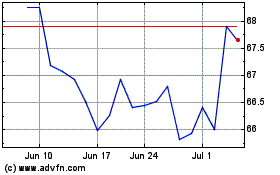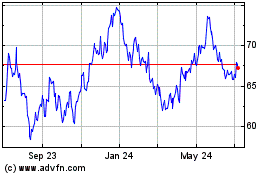Rio Tinto's Incoming CEO Focused on Cash, Projects -- Update
May 05 2016 - 4:38AM
Dow Jones News
By Rhiannon Hoyle
BRISBANE, Australia-- Jean-Sébastien Jacques will take the job
as Rio Tinto PLC's chief executive in July with an unusual
commodity among major mining companies: a growth strategy.
As rivals including Anglo American PLC and Glencore PLC sell
assets to raise capital, Rio Tinto is laying out plans for new
mines, seeking pole position when world commodity markets
recover.
On Thursday, outgoing CEO Sam Walsh said Rio Tinto is completing
plans on its Mongolian Oyu Tolgoi underground copper mine, a
roughly $6 billion project. A proposal to develop a new iron-ore
mine in Western Australia, called Silvergrass, will be assessed "in
the relative near-term," he said. In November, Rio Tinto approved a
$1.9 billion bauxite project in northeastern Australia, which it
aims to complete in 2019 and use to feed China's demand for the
mineral, the raw material of aluminum.
Rio Tinto announced in March that Mr. Walsh would step down
after 3 1/2 years in favor of Mr. Jacques, its former copper chief.
Known in the industry as J.S., he has been the driving force behind
Oyu Tolgoi in recent years.
"I expect J. S. and the team will continue to take those
[projects] forward," Mr. Walsh told reporters after Rio Tinto's
Australian shareholder meeting on Thursday. "It is a good place for
us to be that we can be countercyclical during the cycle."
The company, which has spent billions in recent years to expand
its network of iron-ore pits and infrastructure in Australia's
west, has been criticized for its reliance on iron ore, which in
December fell to its lowest price in roughly a decade. That same
month, Rio Tinto and its Oyu Tolgoi partners-- Turquoise Hill
Resources Ltd. and the Mongolian government--lined up a combined
$4.4 billion from 20 lenders to fund the expansion of the project,
expected to become one of the world's biggest copper
operations.
Most miners have put a pin in new investments as they look to
conserve cash and ride out the downturn, though Anglo-Australian
rival BHP Billiton Ltd.--having slowed new projects--recently
signaled an interest in acquiring mines or oil fields from
rivals.
Rio Tinto has rolled out a growth blueprint despite its
leadership's downbeat view of commodity markets. At the shareholder
meeting, Chairman Jan du Plessis expressed caution on China, the
biggest buyer of commodities such as iron ore and copper. Soft
readings on manufacturing have raised doubts about Beijing's recent
economic stimulus, including strong credit expansion and a
front-loading of 2016 infrastructure budgets.
Mr. Walsh said he is "somewhat negative" on the iron-ore market,
in contrast to those forecasters who project it has passed its
nadir. The price has rebounded to $61 a metric ton from a low below
$37 in December, aided by surging futures speculation in China and
better profits at steel mills.
"The wild card in relation to iron ore at the moment is the
Dalian metal-futures exchange where there are huge quantities of
iron ore being traded," said Mr. Walsh. "That is having an impact
on people's view of iron-ore pricing." Volume and prices have
retreated in recent days, since Dalian Commodity Exchange imposed
measures to cool speculation, including increased transaction
fees.
Mr. Jacques acknowledged the difficult road ahead. "The
macroeconomic environment is tough, and is likely to remain so for
the foreseeable future, from whichever way you look at it," he
said. He sees his job as advancing Rio's best projects and further
increasing its cash reserves.
Having cut operating costs by $6 billion as commodities slid,
Rio aims to cut another $2 billion in two years.
"I think right now is a good time for me to pass the baton, with
the company being as strong as it is," said Mr. Walsh. "It is a
good place where you have stabilized the business and it provides
the opportunities for growth."
Write to Rhiannon Hoyle at rhiannon.hoyle@wsj.com
(END) Dow Jones Newswires
May 05, 2016 04:23 ET (08:23 GMT)
Copyright (c) 2016 Dow Jones & Company, Inc.
Rio Tinto (NYSE:RIO)
Historical Stock Chart
From Mar 2024 to Apr 2024

Rio Tinto (NYSE:RIO)
Historical Stock Chart
From Apr 2023 to Apr 2024
